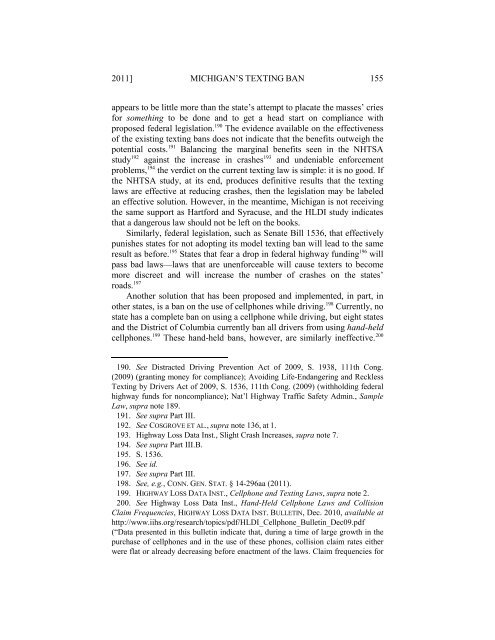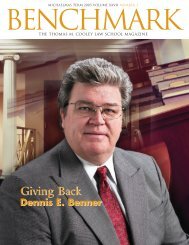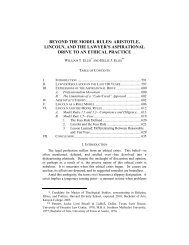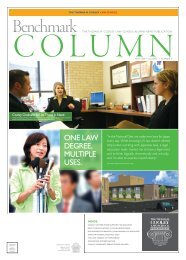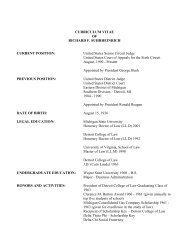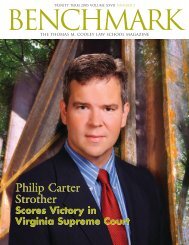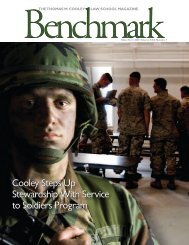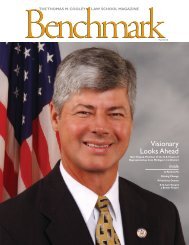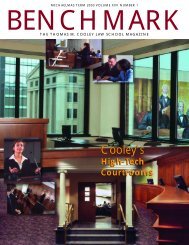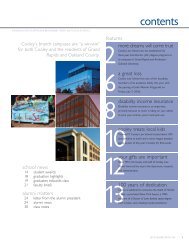Michigan's Texting Ban: One Step Forward, Too Many Steps Back
Michigan's Texting Ban: One Step Forward, Too Many Steps Back
Michigan's Texting Ban: One Step Forward, Too Many Steps Back
- No tags were found...
You also want an ePaper? Increase the reach of your titles
YUMPU automatically turns print PDFs into web optimized ePapers that Google loves.
2011] MICHIGAN’S TEXTING BAN 155appears to be little more than the state’s attempt to placate the masses’ criesfor something to be done and to get a head start on compliance withproposed federal legislation. 190 The evidence available on the effectivenessof the existing texting bans does not indicate that the benefits outweigh thepotential costs. 191 Balancing the marginal benefits seen in the NHTSAstudy 192 against the increase in crashes 193 and undeniable enforcementproblems, 194 the verdict on the current texting law is simple: it is no good. Ifthe NHTSA study, at its end, produces definitive results that the textinglaws are effective at reducing crashes, then the legislation may be labeledan effective solution. However, in the meantime, Michigan is not receivingthe same support as Hartford and Syracuse, and the HLDI study indicatesthat a dangerous law should not be left on the books.Similarly, federal legislation, such as Senate Bill 1536, that effectivelypunishes states for not adopting its model texting ban will lead to the sameresult as before. 195 States that fear a drop in federal highway funding 196 willpass bad laws—laws that are unenforceable will cause texters to becomemore discreet and will increase the number of crashes on the states’roads. 197Another solution that has been proposed and implemented, in part, inother states, is a ban on the use of cellphones while driving. 198 Currently, nostate has a complete ban on using a cellphone while driving, but eight statesand the District of Columbia currently ban all drivers from using hand-heldcellphones. 199 These hand-held bans, however, are similarly ineffective. 200190. See Distracted Driving Prevention Act of 2009, S. 1938, 111th Cong.(2009) (granting money for compliance); Avoiding Life-Endangering and Reckless<strong>Texting</strong> by Drivers Act of 2009, S. 1536, 111th Cong. (2009) (withholding federalhighway funds for noncompliance); Nat’l Highway Traffic Safety Admin., SampleLaw, supra note 189.191. See supra Part III.192. See COSGROVE ET AL., supra note 136, at 1.193. Highway Loss Data Inst., Slight Crash Increases, supra note 7.194. See supra Part III.B.195. S. 1536.196. See id.197. See supra Part III.198. See, e.g., CONN. GEN. STAT. § 14-296aa (2011).199. HIGHWAY LOSS DATA INST., Cellphone and <strong>Texting</strong> Laws, supra note 2.200. See Highway Loss Data Inst., Hand-Held Cellphone Laws and CollisionClaim Frequencies, HIGHWAY LOSS DATA INST. BULLETIN, Dec. 2010, available athttp://www.iihs.org/research/topics/pdf/HLDI_Cellphone_Bulletin_Dec09.pdf(“Data presented in this bulletin indicate that, during a time of large growth in thepurchase of cellphones and in the use of these phones, collision claim rates eitherwere flat or already decreasing before enactment of the laws. Claim frequencies for


